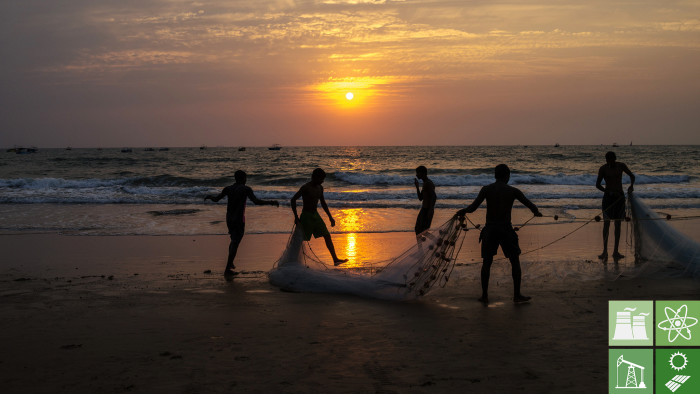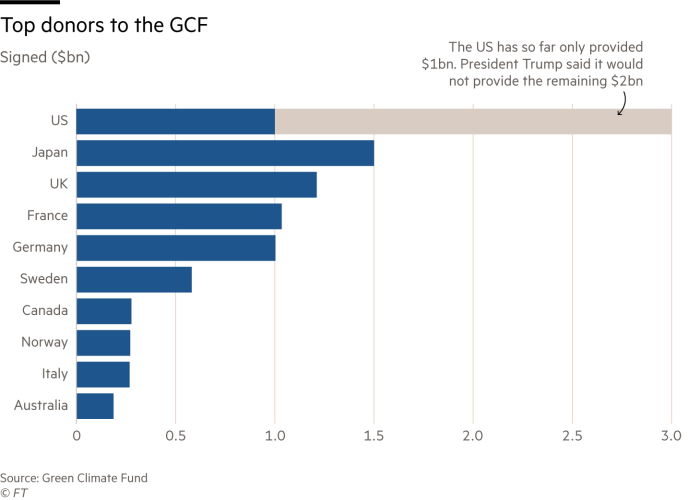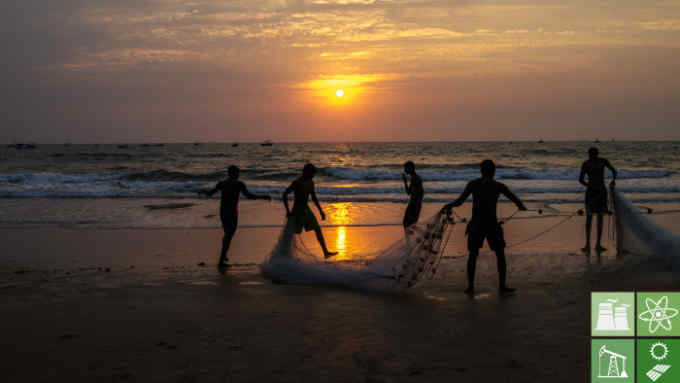UN’s flagship green finance fund fights to regain credibility

Simply sign up to the Climate change myFT Digest -- delivered directly to your inbox.
In the world of development funding there is nothing quite like the Green Climate Fund: a UN-backed group that was designed to break the mould of traditional aid, and create a new model for how rich countries could help poor countries address climate change.
This year is set to be a crucial test for the young fund, as it sets out to raise billions of dollars from donor countries, while simultaneously pushing through governance reforms and appointing a new head.
The Green Climate Fund — which is the biggest global climate fund in the world — is also working to recover credibility, after a board meeting last summer collapsed, giving rise to accusations that the fund has been paralysed by politics and bureaucracy.
Alexandra Tracy, a board observer at the GCF representing the private sector, says it is a “make or break” year for the fund. “The most challenging and probably the most crucial issue is to tackle the issue of how to move forward when there is not consensus at the board,” she adds.
Javier Manzanares, interim director the GCF, says governance reforms are at the top of the agenda for the upcoming board meeting in February.
“I’m confident that the GCF is on the right path, and I’m confident that the board will keep on making the right decisions in terms of governance, and in terms of [financial] replenishment,” he says.
No target for the new fundraising has been set yet, but Mr Manzanares points out that the fund has a $17bn backlog of proposals, indicating the scale of what is needed.
Germany and Norway both came forward last month and pledged to double their financial commitments to the GCF during its new funding round. However due to the lack of financial support in the US — where President Trump has cancelled $2bn of the US’s original $3bn GCF pledge made by former president Barack Obama in 2014 — it could be an uphill battle.
“2019 is a critical year for the GCF,” says Rachel Kyte, a senior UN energy official. “Anything less than a robust replenishment casts a pall upon the international processes,” she adds, referring to the fundraising.

At a time when climate change concerns are becoming a bigger priority for governments, global climate finance is struggling to keep pace with the scale of the threat, and a pledge by rich countries to spend $100bn annually helping poor countries fight climate change is still far from being met.
The promise of financial help for less developed countries has been a core part of all international climate deals, but details like who pays and how the money is allocated have been highly contentious.
Based in Songdo, South Korea, the GCF raised $8bn in its initial round of fundraising. Of that some $427m has already been disbursed, and $4.6bn has been allocated to approved projects, which can range from clean cooking programmes in Bangladesh, to loans for energy efficiency in Mongolia.
However the governance model that was seen as pioneering back when the fund received its first pledges in 2014 — a consensus-based board with 24 members, split evenly by developed and developing countries — has been sorely tested over the past year.
Governance reforms are now seen as a critical part of raising more money, as donor countries have become increasingly concerned about the fund’s ability to function efficiently.
“The real question this year will be, can the GCF make the changes and reforms to strengthen its processes,” says Leonardo Martinez-Diaz, who sat on the GCF board for three years, and is now head of sustainable finance at the World Resources Institute. “You are dealing with a complicated governance system.”
Operating by consensus has become one of the key sources of tension. Next month the board will consider whether it might move to a system of using voting, rather than consensus, to approve new projects and policies.
“That is of course an absurd paradox where they have to decide by consensus, how you move on from consensus,” points out Ms Tracy. “I think a lot of potential donors will be looking for a change in governance and decision making, because they see these bottlenecks, they see these things getting stuck.”
Meetings of the board, which has 24 members and operates only by consensus, are “problematic” and “often difficult”, according to Jakob Waslander, a former board member representing the Netherlands, and now a senior associate at WRI.
Things came to a head in a fiery board meeting last July, in which the board bickered for days, and failed to approve any new projects before the weeklong meeting concluded.
Even Mr Manzanares acknowledges how challenging the consensus process can be. “It is a very rich process, but it is painful and perhaps not the most efficient,” he says. He adds that he is “confident” that the board will soon tackle a decision about whether to use voting procedures instead.

Comments